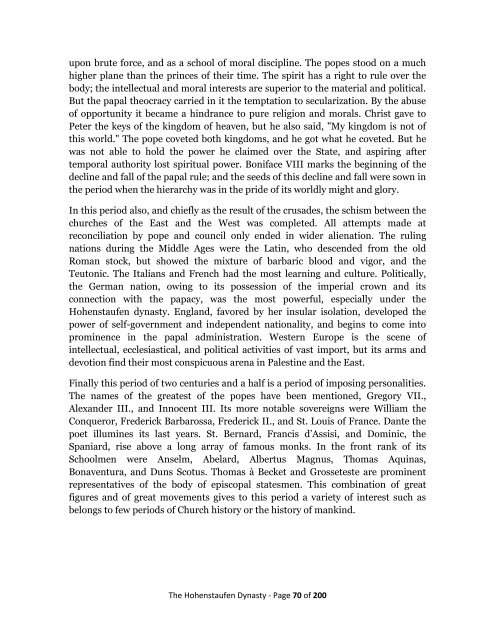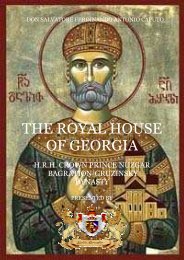here - Nobility Associations
here - Nobility Associations
here - Nobility Associations
Create successful ePaper yourself
Turn your PDF publications into a flip-book with our unique Google optimized e-Paper software.
upon brute force, and as a school of moral discipline. The popes stood on a much<br />
higher plane than the princes of their time. The spirit has a right to rule over the<br />
body; the intellectual and moral interests are superior to the material and political.<br />
But the papal theocracy carried in it the temptation to secularization. By the abuse<br />
of opportunity it became a hindrance to pure religion and morals. Christ gave to<br />
Peter the keys of the kingdom of heaven, but he also said, "My kingdom is not of<br />
this world." The pope coveted both kingdoms, and he got what he coveted. But he<br />
was not able to hold the power he claimed over the State, and aspiring after<br />
temporal authority lost spiritual power. Boniface VIII marks the beginning of the<br />
decline and fall of the papal rule; and the seeds of this decline and fall were sown in<br />
the period when the hierarchy was in the pride of its worldly might and glory.<br />
In this period also, and chiefly as the result of the crusades, the schism between the<br />
churches of the East and the West was completed. All attempts made at<br />
reconciliation by pope and council only ended in wider alienation. The ruling<br />
nations during the Middle Ages were the Latin, who descended from the old<br />
Roman stock, but showed the mixture of barbaric blood and vigor, and the<br />
Teutonic. The Italians and French had the most learning and culture. Politically,<br />
the German nation, owing to its possession of the imperial crown and its<br />
connection with the papacy, was the most powerful, especially under the<br />
Hohenstaufen dynasty. England, favored by her insular isolation, developed the<br />
power of self-government and independent nationality, and begins to come into<br />
prominence in the papal administration. Western Europe is the scene of<br />
intellectual, ecclesiastical, and political activities of vast import, but its arms and<br />
devotion find their most conspicuous arena in Palestine and the East.<br />
Finally this period of two centuries and a half is a period of imposing personalities.<br />
The names of the greatest of the popes have been mentioned, Gregory VII.,<br />
Alexander III., and Innocent III. Its more notable sovereigns were William the<br />
Conqueror, Frederick Barbarossa, Frederick II., and St. Louis of France. Dante the<br />
poet illumines its last years. St. Bernard, Francis d’Assisi, and Dominic, the<br />
Spaniard, rise above a long array of famous monks. In the front rank of its<br />
Schoolmen were Anselm, Abelard, Albertus Magnus, Thomas Aquinas,<br />
Bonaventura, and Duns Scotus. Thomas à Becket and Grosseteste are prominent<br />
representatives of the body of episcopal statesmen. This combination of great<br />
figures and of great movements gives to this period a variety of interest such as<br />
belongs to few periods of Church history or the history of mankind.<br />
The Hohenstaufen Dynasty - Page 70 of 200



